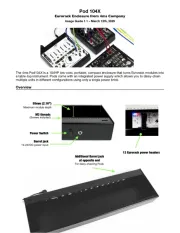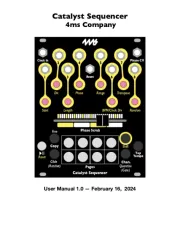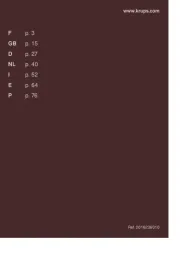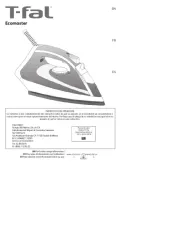4ms Tapographic Delay Bedienungsanleitung
4ms
Nicht kategorisiert
Tapographic Delay
Lies die bedienungsanleitung für 4ms Tapographic Delay (20 Seiten) kostenlos online; sie gehört zur Kategorie Nicht kategorisiert. Dieses Handbuch wurde von 33 Personen als hilfreich bewertet und erhielt im Schnitt 4.6 Sterne aus 17 Bewertungen. Hast du eine Frage zu 4ms Tapographic Delay oder möchtest du andere Nutzer dieses Produkts befragen? Stelle eine Frage
Seite 1/20

Tapographic Delay
from 4ms Company and Matthias Puech
User Manual 1.0 – November 3, 2017
for firmware v1.0

Table of Contents
Introduction 3
Background 4
What’s a multi-tap delay? 4
What’s a tapography? 6
Installation 6
Getting started: Your first TD patch 7
Create a new Tapography 7
Editing your Tapography 8
Saving your Work 8
Explore the Knobs 8
Explore the Switches 8
Explore the Buttons 9
Sequencer Mode 9
Controls 9
Signal path 12
Editing tapographies 13
Entering Taps 13
ADD/OFF/INS Switch 13
RES/AMP/LPF Switch 14
Upper Button Row 14
Settings Menu 14
Navigating tapographies 16
Loading a tapography 16
Saving a tapography 16
Sequencer mode 17
Advanced features 17
Velocity normalization jumper 17
Firmware update 18
Calibration 19
Factory tapographies 19
Banks A - D 19
Reset a bank to factory default 21
Acknowledgments 21
Page
2

Introduction
The Tapographic Delay is a complex multi-tap delay in the Eurorack format with a unique
interface designed for live performance. It excels at transforming the simplest audio (a
drone, a percussive sound) into complex rhythmic structures, meshes of organic textures,
lush harmonic mille-feuilles, liquid and resonant effects… plus everything we have not
explored yet!
Have you ever got tired of the monotonous repetitions that your standard delay
pedal/module produced? Have you ever wished for a more complex rhythmic structure than
just decaying repetition? If yes, you have come to the right place: the Tapographic Delay is
an advanced effect that lets you handle repetition in ax completely novel way. It is in a way
to a traditional delay what a full rhythmic sequencer (with pattern recall, velocity control,
tactile input) is to a simple clock. With the TD, you interactively define the rhythm that the
repetitions will follow: a velocity-sensitive sensor allows you to record, edit, modify, and
sequence your own arrangements of delays. In a sense, the TD is the converse of the
classic Frippertronics sound-on-sound setup popularized by Robert Fripp in the 70’s: you
don't play the guitar, you play the tape loop!
The Tapographic Delay is an expressive experimental instrument meant to be played in
real-time, rather than a set-and-forget end-of-chain effect. Interact with it! Experiment! Push
it to its limits!
●Velocity-sensitive force sensor to tap the delay configurations ( tapographies
)
●Up to 32 taps, each with its own delay time, amplitude/filter and panning
●Low-pass filter or resonant (pingable) band-pass filter on each tap
●Morphing between delay configurations, with adjustable morph time
●Two different feedback paths: a Repeat toggle and a Feedback knob
●Save and recall up to 24 delay configurations (4 banks of 6 slots each)
●Tapography sequencer with forward, random walk or random directions
●Synchronization to an external clock, with clock divider/multiplier
●Gate output that plays the current rhythm of delays
●Maximum delay time of 174 seconds (almost 3 minutes)
●16 bits/48kHz with 32 bits floating-point internal processing, 1.3ms software latency
●Mono-in, stereo-out operation
●18HP Eurorack module
●Current consumption: 125mA of +12V; 32mA of -12V. (10-to-16pin cable included)
●0.98" (25mm) maximum depth with power cable
●Dry frequency response: 20Hz - 5kHz: +/-0.1dB. @10kHz: -2.3dB. @20kHz: -7.8dB
●Audio inputs max 22Vpp. Audio outputs soft-limit at max 17Vpp
●Trigger/clock inputs: +2V minimum, +12V maximum
●Gate (trigger) output: +8V, 4ms pulse width
Page
3
Produktspezifikationen
| Marke: | 4ms |
| Kategorie: | Nicht kategorisiert |
| Modell: | Tapographic Delay |
Brauchst du Hilfe?
Wenn Sie Hilfe mit 4ms Tapographic Delay benötigen, stellen Sie unten eine Frage und andere Benutzer werden Ihnen antworten
Bedienungsanleitung Nicht kategorisiert 4ms

1 August 2025

22 September 2024

3 September 2024

23 August 2024

23 August 2024

17 August 2024

11 August 2024

7 August 2024

26 Juli 2024

24 Juli 2024
Bedienungsanleitung Nicht kategorisiert
- Interstuhl
- Pabobo
- Master Kitchen
- Ariete
- Bose
- AG Neovo
- ZKTeco
- Testec
- SSL
- Vinpower Digital
- Ibico
- Plugwise
- Kisag
- Harvia
- Moxa
Neueste Bedienungsanleitung für -Kategorien-

20 August 2025

20 August 2025

20 August 2025

20 August 2025

20 August 2025

20 August 2025

20 August 2025

20 August 2025

20 August 2025

20 August 2025